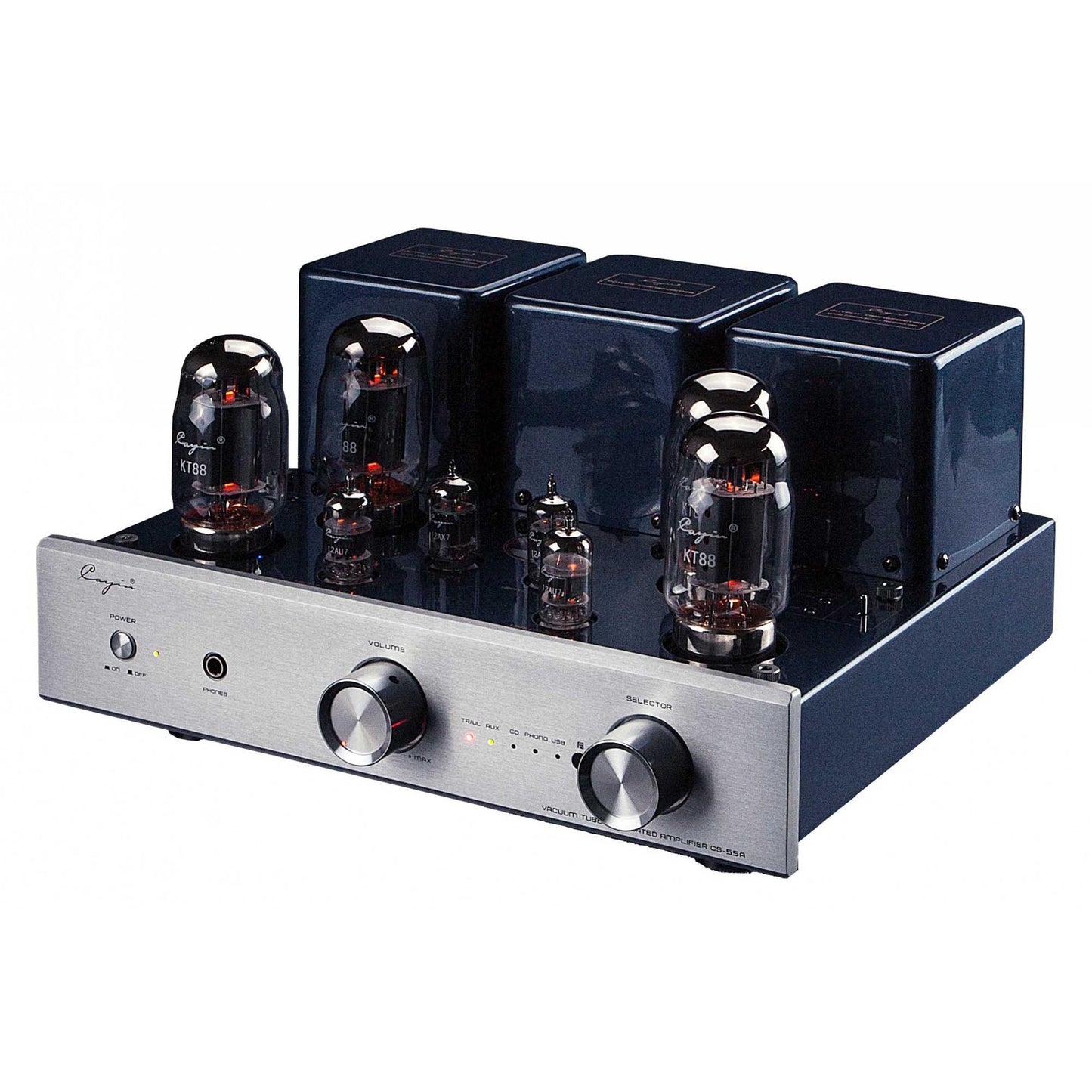
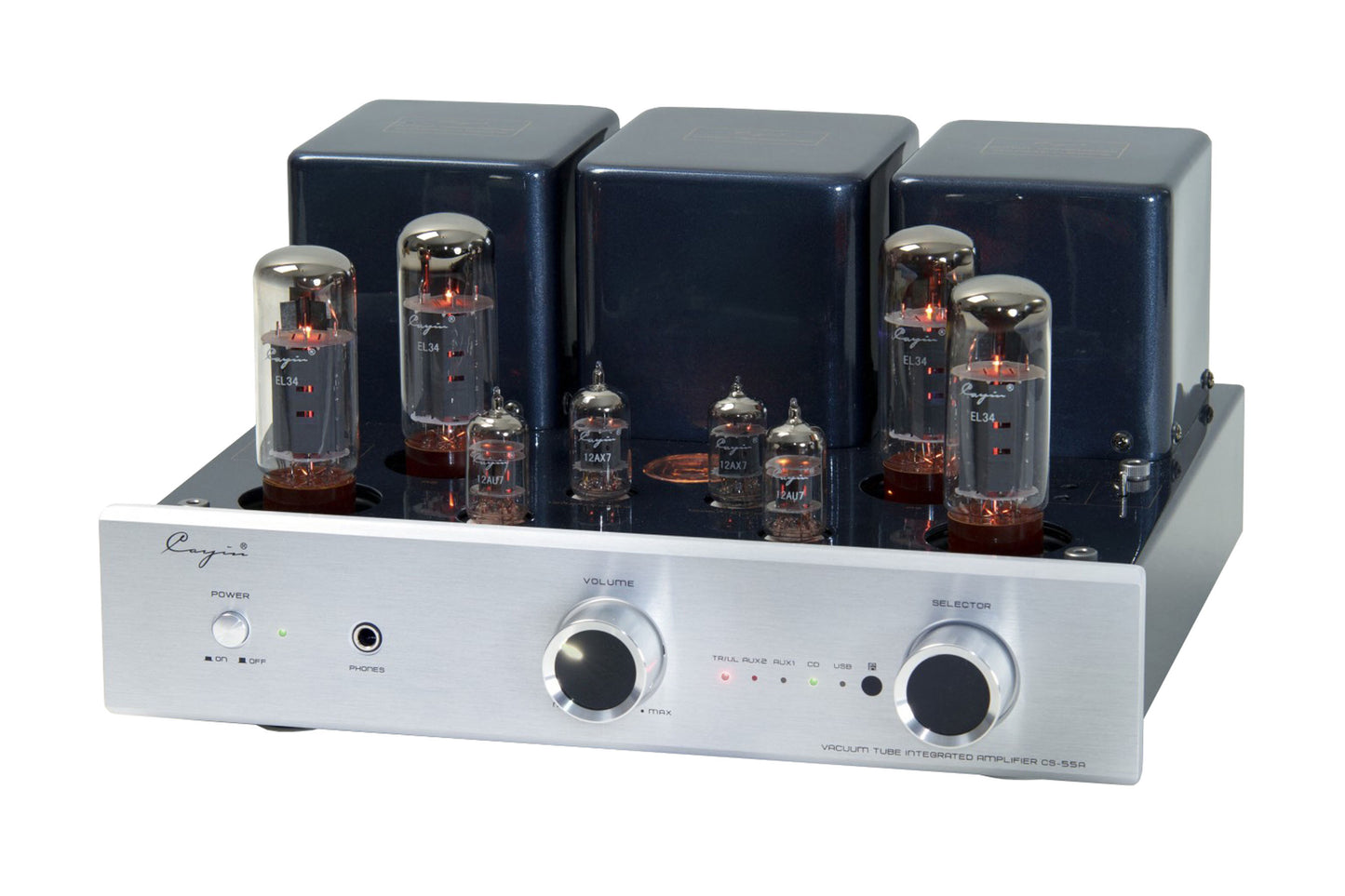
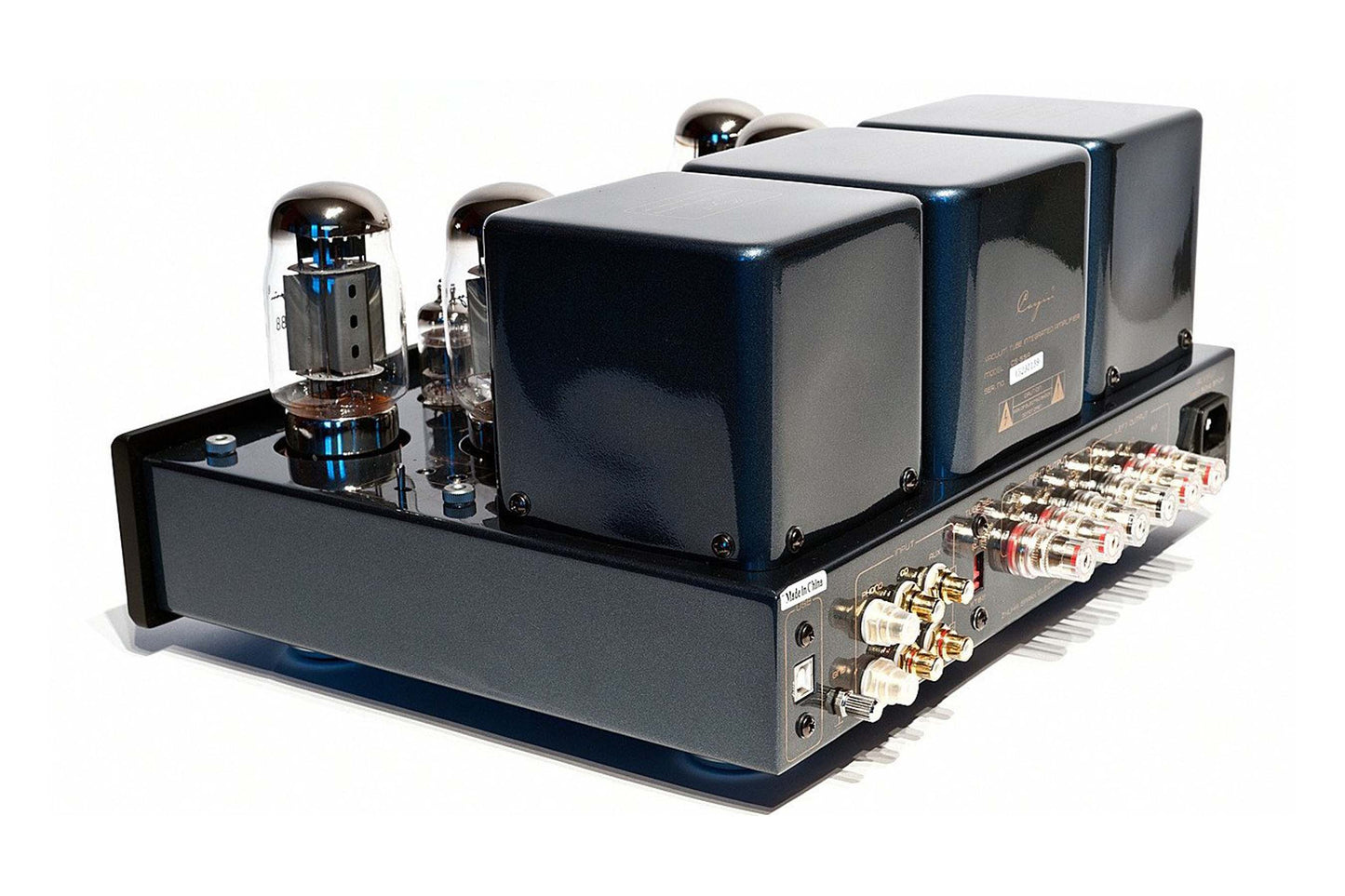
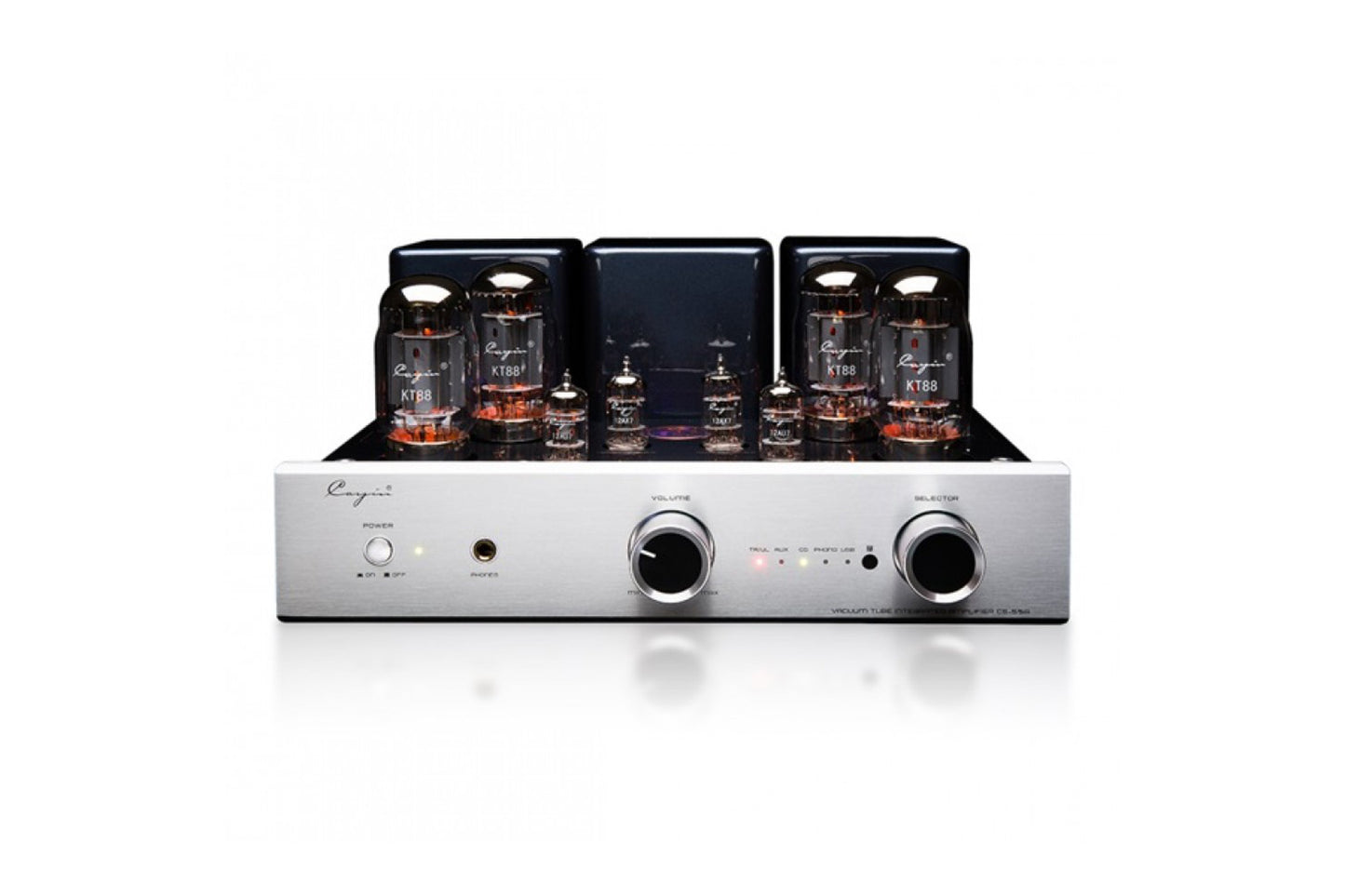
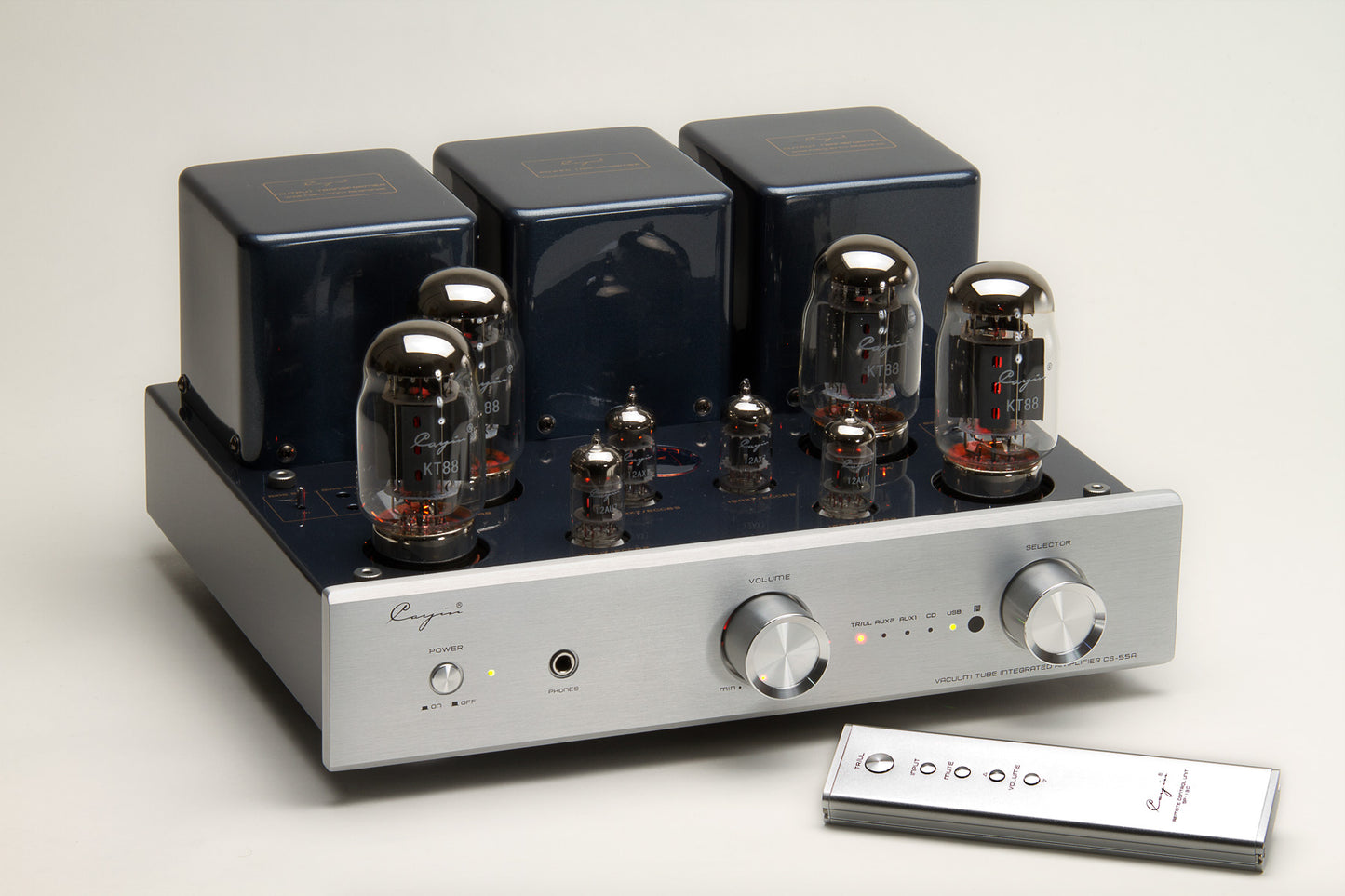
About The Cayin CS-55A Stereo Amplifier
Versatility is the Cayin CS-55A Integrated Valve Amplifier's middle name as it features both a built-in MM Phono stage to connect a turntable and a 32 bit/384kHz DAC for your digital sources.
The Zhuhai Spark Electronic Equipment Company (cool name) was founded in Guangdong, China in 1993 and is devoted to the design and production of great sounding high-end audio equipment under the brand name Cayin.
And before you write this fine company off just because it designs & manufactures its products in China, please be aware of a couple of points: firstly, nearly all the products we stock from established audio companies, such as Cambridge Audio & NAD, are manufactured at state of the art facilities in China. The second point is that the Chinese domestic market is huge and there are many audiophiles who not only buy home grown products (like Americans who buy McIntosh) but also own and operate serious audio companies such as Cayin. Cayin was specifically set up to supply the quality end of the audio market and specialise in valve amplifiers based on the iconic Saul B. Marantz Models 7 and 8 of the 1960's which were famous for their sweet, natural and exceptionally musical sound.
This CS-55A model is the most versatile in the range with a suite of facilities sure to impress. The CS-55A sports a built-in MM Phono stage to connect a turntable and a 32 bit/384kHz DAC for your digital sources as well as the added convenience of a headphone socket for those private listening sessions.
As with the rest of the range it comes with point-to-point wiring, audio grade capacitors, carbon film resistors and wide bandwidth EI output transformers to provide that much needed current to your speakers.
Unlike valve amps of yore, all functions on the CS-55A are remote controlled including the superb motorised Alps volume-control. It weighs in at a weighty 17 kilos (blame those output transformers) and has a valve complement of two 12AX7 and two 12AU7 in the preamp & driver stages and four KT88's providing power in the output stage. This gives a very tidy 40 watts in Ultra-Linear mode and a still healthy 22 watts in Triode mode.
Ultra-Linear & Triode Mode
Ultra-Linear & Triode modes? Please explain. Well, first of all, there are three common types of Valves/Tubes (Valves in British English, Tubes in American English) used in the output stage of an amplifier: Triodes, Pentodes & Tetrodes.
Triodes (300B etc) are used in Single Ended Triode (SET) amplifiers that only output a few (very pure) watts. These amps rarely venture above 7 or 8 watts which means the speakers they can be used with need to be extremely efficient. This type of amplifier and this type of speaker are the exception rather than the rule.
Far more common are Push-Pull valve amplifiers, such as the CS-55A featured here, which use either Pentodes (EL34 etc) or Tetrodes (KT88 etc) running in Ultra-Linear to provide a very usable amount of wattage (30 – 80 watts) for the vast majority of speakers. Some companies, such as Cayin, in order to offer the pure sound of Triodes in a push-pull amplifier, provide a way to switch the Pentode or Tetrode output valves into Triode mode. Although this generally gives a sweeter sound, the trade off is a much lower power output of approximately half the normal Ultra-Linear operation. Depending on your speakers, the size of the room and the volume you like to listen at, Triode mode may or may not be a happy match with you and your system.
Valve/Tube Rolling
Unlike transistor amps where the output transistors are soldered in, most valves are fitted to valve sockets which allow the valve to be easily changed, either for a replacement, in the case of failure, or for a different type of valve. This practice of swapping valves to different models or different versions of the same valve is known as valve/tube rolling and allows you to fine tune the sound of the amplifier to your liking. Some of our customers have a host of valves they regularly change depending on their mood or the music they are playing. Of course you do need to be careful to only use the types of valves the manufacturer suggests – in the case of the Cayin CS-55A it is a choice between the supplied KT88's or the ever popular EL34's which are readily available. A valve selection switch is provided on the rear of the amplifier.
Valve vs Solid State
The whole Valve/Tube or Solid-State dilemma is not as complicated as you might think. Once you accept the reality that a valve amp and a solid-state amp are very different in how they operate, you'll perhaps better understand that each have their own traits.
The biggest difference between them is that a solid-state amp is driven by current through the output devices and a valve is driven by voltage. Voltage alone can't drive a speaker, hence the reason for needing output transformers. You'll notice most stereo valve amps have 3 large, heavy objects, typically at the rear. They are a power transformer and two output transformers (one for each channel) that convert the voltage from the output valves to current at the speaker connections. A solid-state amp typically has a single power transformer and no output transformers. However, a solid-state output transistor and a valve basically do the same thing. One doing it in silicone with current and the other doing it in a glass vacuum with voltage.
Do they sound different? Yes, they do. However, some valve companies make their valve amps sound more solid-state like (for power) and some solid-state products can sound very valve-like. A key difference is that a valve product will require a small amount of upkeep and maintenance. For most who desire the benefit of valves, it's a small price to pay. Others just don't want to maintain an amp once installed.
Back to the sound. First, let's squelch the myth that valve amps don't have strong or controlled bass. Today, that couldn't be further from the truth. Let's also put aside the thought that solid-state amps aren't smooth. Like any product from any manufacturer, all amplifiers have a certain inherent sound signature which will attract different people. There are benefits and drawbacks to each, but one must weigh each depending on what you are looking to achieve in your audio system both in terms of sonics and upkeep as well as taking the rest of the system into consideration.
So, what are the benefits of each? Generally speaking, valves offer a greater sense of bloom, more texture and realism to vocals and instruments and a richer midrange. Solid-state usually offers more watts per dollar, faster sound and greater detail. Once again these are generalizations. If you have a system that overall is a bit harsh or fatiguing, chances are you could greatly benefit from a valve amp. On the other hand, if your system is flat, sluggish, or too soft sounding, perhaps a quality solid-state amp is the way to go. Other factors of particular importance are speaker load. Some speakers (although few today) require lots of power and very low impedance driving capabilities. In that scenario, a solid-state amp may do better. But, if your speakers have a moderate impedance curve (6 to 8 Ohms) and are of average efficiency (86dB or above), a valve amp can redefine your definition of what a great audio system can sound like.
Our Take
Let's face it. You either 'GET' valve amps, or you don't. It's the same kind of allure that has attracted people back to vinyl. They're a little more hands on, a little more involving and that warm glow in low light sure does set the mood. Don't be fooled into thinking though that valve amps only work well with record players. Oh no, in fact you could almost say that digital music played back from music streamers or CD players provide the perfect match for a valve amp. Valve amps seem to have a certain richness to their sound that perfectly complements the clarity of digital.
The Cayin CS-55A is set up out of the box to take full advantage of digital music with a high quality DAC with 32 bit/384 kHz capability built right in. Connection is via USB B 2.0 to ensure great signal quality from your connected computer. The CS-55A also plays along stereotypical lines by offering every valve amp owners favourite, a quality MM Phono input for hooking up your precious turntable and playing all those fascinating big black vinyl discs. If a versatile valve amp with good power & plenty of options and facilities is what you're looking for, look no further.
Main Features & Specifications
- Design: Integrated Valve Amplifier
- Power Output:
-
- 22 Watts per channel (Triode)
- 40 Watts per channel (Ultra-Linear)
- Frequency Response: 5Hz - 44kHz (-3dB)
- Signal to Noise (S/N) Ratio: 92dB
- Construction: Hand-made construction with point-to-point wiring
- Capacitors: Audio grade capacitors
- Resistors: Carbon film resistors
- Output Transformers: Two wide bandwidth EI output transformers
- Power Supply: Specially designed toroid transformer for the power supply
- Valves: Two 12AX7 and two 12AU7 valves in the preamp & driver stages
- Four KT88 valves are used in Class AB1 push-pull output stage
- Selectivity: Triode and Ultra-linear selection via remote
- Bias Adjustment: Easy valve bias adjustment using the top mounted bias meter
- Rear Panel Switch: Switch easily between the supplied KT88 output valves or optional EL34 valves via a convenient rear panel switch
- Remote Control: Comprehensive remote control featuring volume, mute, input and ultra-linear/triode mode selection
- Line-Level Inputs: Two stereo line level inputs
- Phono Input: One stereo MM phono input for connecting a turntable
- USB Input: One 2.0 USB B connection for connecting a computer
-
- Word Length: 16 – 32 bits
- Sampling Rates: 44.1kHz, 48kHz, 88.2kHz, 96kHz, 176.4kHz, 192kHz, 352.8kHz, 384kHz
- Operating System: Windows XP, Windows Vista,Windows 7 , Windows 8, Mac OS(10.6.3 and above)
- Soft Start Function: 30 second soft start function - extends the life of internal components and valves
- Silver Plating: Heavily silver-plated signal cables are used throughout
- Cover: An easily removed cover is provided for protection from hot valves
- Speaker Binding Posts: Accepts Banana plugs or spade terminals
- Output Impedance: 4 Ohms and 8 Ohms
- Power Consumption: <480 Watts
- Power Cord: Standard IEC that can be easily upgraded
- Dimension (WxHxD): 360 x 180 x 334mm
- Net Weight: 17 kg
- Manufacturer's Warranty: 2 Years Electronics, 6 Months Valves
Note: Features & Specifications Subject To Change Without Notice. E&OE.





